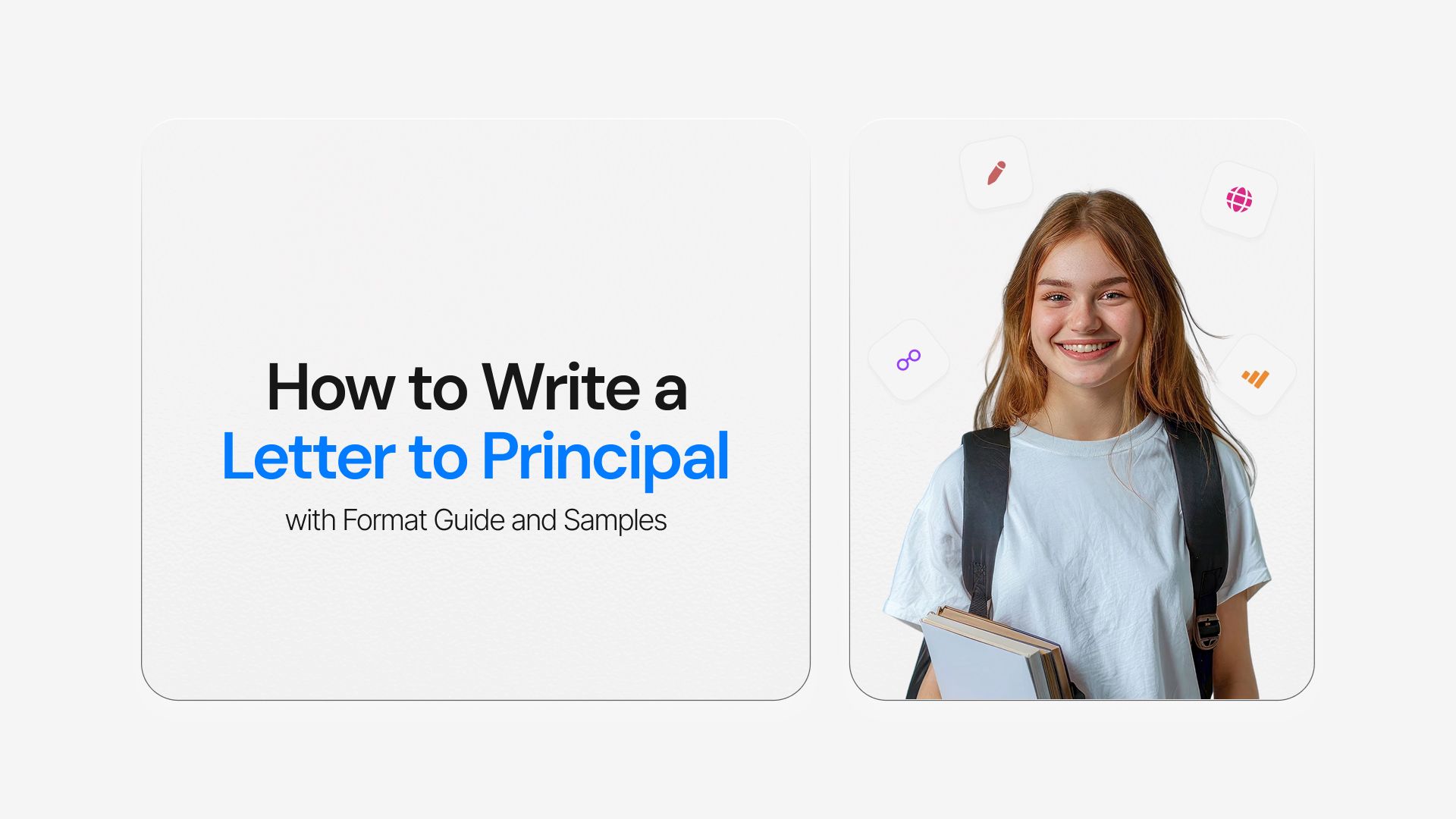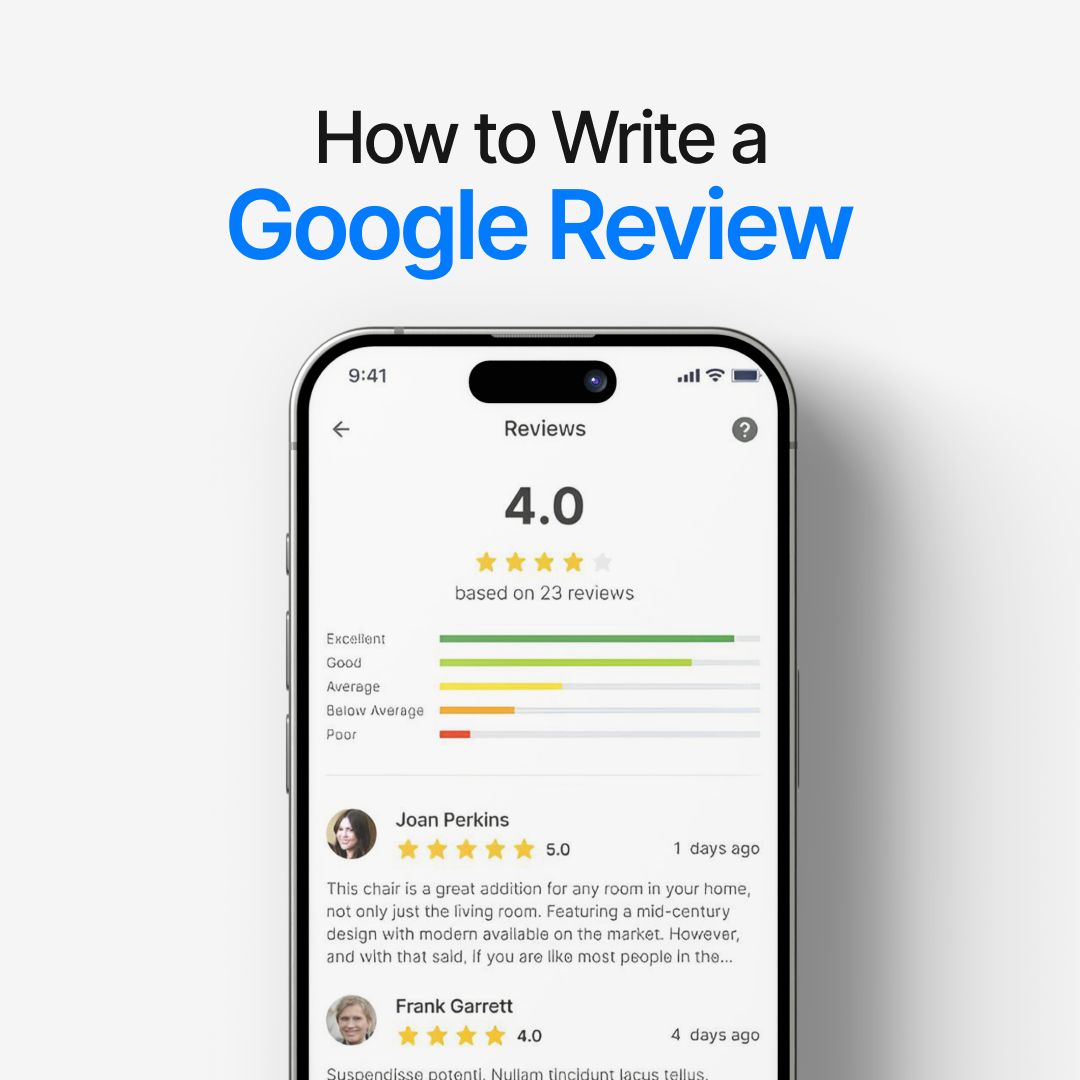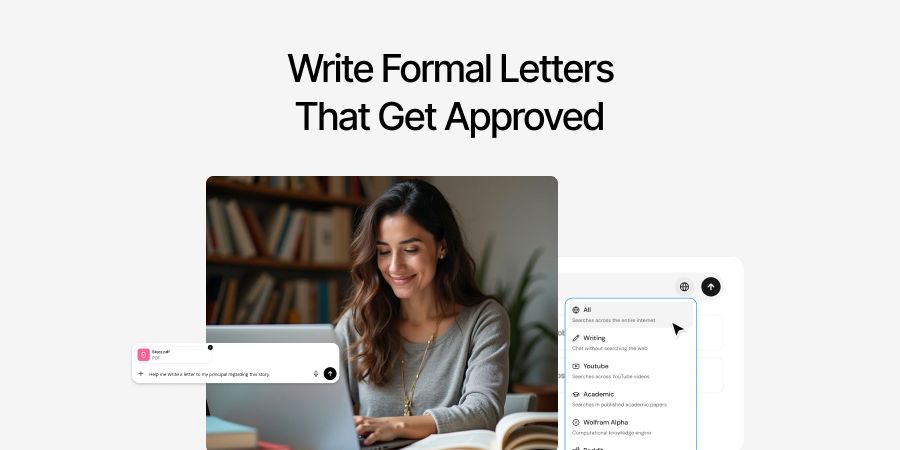
How To Write A Letter To The Principal, with Format Guide and Samples
School life often requires formal communication, that is both customary and mandatory. A leave request today, a permission letter tomorrow, a transfer certificate next month.
A clear letter to the principal saves time, prevents back-and-forth, and increases the chance of approval. Most rejections happen for simple reasons, not intent. Missing details. Vague subject lines. Casual tone.
This guide sets a clean baseline. You will learn the expected format for a formal letter to the principal, core elements every application to principal must include, and how to present your request so it is read, understood, and acted on. Templates and examples come later. First, a crisp definition and the rules that do not change.
What Is A Letter To The Principal?
A letter to the principal is a formal request addressed to the head of the school by a student, parent, or staff member.
The purpose can vary: leave application, permission for an event, section change, fee concession, complaint, or certificates. The form does not. Schools expect a standard business-style format, a respectful tone, and complete, verifiable details.
A strong letter to principal includes six essentials:
-
Sender details that identify you clearly. Name, class or role, and contact.
-
Date and receiver details. “The Principal” and correct school name.
-
A short subject line that states the request in plain words.
-
A direct opening that explains who you are and why you are writing.
-
Specifics that support the request. Dates, reasons, documents, and any prior approvals.
-
A polite close with thanks, your name, and signature.
Clarity matters more than style. Keep sentences short. Place the main ask near the top. Avoid emotional language when a factual line works better. One page is ideal. A concise, well formatted application to the principal reads like a checklist the school can process fast.
Common use cases include:
-
Leave letters for illness or family travel with exact dates.
-
Permission to participate in competitions, events, or external exams.
-
Requests for transfer certificates, bonafide certificates, or fee concessions.
-
Section or stream change applications with a brief academic reason.
-
Parent letters reporting concerns about safety, bullying, or academic issues.
Email or print both work when the school allows it. Printed letters remain common for records. Email should mirror the same structure: clear subject, formal salutation, and the body formatted like a standard letter. Attachments should match what you reference in the text.
The goal is simple. Help the principal decide quickly with complete information and a respectful tone. In the next section, we will lay out the exact format and step-by-step structure you can reuse for any request.
Standard Format Of A Letter To Principal
A principal’s office expects structure. Without it, letters look casual and lose credibility. A formal application to principal follows a predictable pattern that makes reviewing faster. It is not complicated, but every element carries weight.
Sender’s Details
Start with your name, class, roll number, or role in the school. Parents should add their child’s name and class. This ensures the office identifies the student linked to the request.
Date And Receiver’s Details
The date sits below the sender’s block. Then comes “The Principal” followed by the school name and address. This section confirms where the letter belongs in official records.
Subject Line
Keep the subject one line, clear, and factual. “Leave application for three days” or “Request for transfer certificate.” Subjects that try to explain too much end up unclear.
Salutation
Use “Respected Sir/Madam” or “Dear Principal.” Never begin with casual greetings. Respect sets the tone for how the letter will be received.
Body Of The Letter
Here is where you state the reason for writing. Open with a short introduction. “I am a student of Class 8B” or “I am the parent of Riya Sharma, Class 5A.” Then move quickly into the purpose of the letter. Provide supporting details: dates, duration, reasons, and any documents attached. The body should be direct, polite, and never longer than three short paragraphs.
Closing And Signature
Thank the principal for considering the request. Sign off with “Yours sincerely” or “Yours faithfully.” Below that, write your full name. Students can add their respective roll number and class. Parents can mention their relation to the student.
Key Pointers To Remember
-
Align all text to the left for a professional look.
-
Keep the letter one page or less.
-
Always specify dates in full: “12 September 2025 to 15 September 2025.”
-
Attach medical notes, consent forms, or supporting documents where relevant.
-
Review grammar and spelling before submitting. Errors weaken the impact.
This format is universal. Whether you are applying for leave, seeking a certificate, or requesting permission, the structure stays constant. Schools trust clarity. In the next section, we move into the step-by-step process of drafting a letter that reads smoothly and delivers exactly what the school needs to approve your request.
Step By Step Guide To Writing A Letter To Principal
Writing to a principal demands more than polite words. The letter must communicate your purpose with clarity, carry all required details, and follow the formality of school communication.
Here is the step-by-step guide that makes the process simple.
Introduce Yourself Clearly
Begin by stating who you are. If you are a student, mention your full name, class, and roll number. Parents should add their child’s information. Teachers or staff should note their designation. This opening line establishes identity and ensures the request links to school records.
State The Purpose Directly
Do not wait until the second paragraph. Mention the purpose of the letter at the start. If you seek leave, permission, or a certificate, put it forward immediately. Vague openings create confusion and may delay approval.
Provide Exact Details
Specificity builds trust. Add dates, time periods, or context that supports the request. “I request leave from 10 October to 13 October due to illness” is stronger than “I need some days off.” If you are requesting documents, specify which ones and why.
Keep The Tone Respectful
Respectful language is critical in a formal letter to the principal. Avoid casual phrases or emotional exaggeration. Polite, professional wording reflects sincerity and improves the chances of your letter being accepted without revisions.
Organize The Letter Logically
Follow a flow: introduction, purpose, supporting details, closing. Each paragraph should handle one idea. This structure prevents repetition and makes the letter easier for the principal to read.
Close With Gratitude And Signature
End by thanking the principal for their time and consideration. Use a closing phrase such as “Yours sincerely” followed by your name. Students should include roll number and class; parents should add their relationship to the child.
Bonus: Checklist Before Submitting the Letter
Before submitting the letter, ensure that:
-
The subject line is short and precise.
-
Full name, class, and details are included.
-
Dates and reasons are clearly mentioned.
-
The letter fits within one page.
-
Closing is polite and professional.
A letter built with these steps looks professional, communicates without confusion, and stands a far higher chance of approval. Next, we explore real sample letters that show how this structure works in different scenarios.
Sample Letters To Principal
Examples make the process easier. Seeing a complete letter in action shows how each part fits together and how tone, structure, and detail combine to create impact. Here are practical samples covering common scenarios.
-
Leave Application For Illness
Subject: Request for Medical Leave
Respected Principal,
I am James Carter, a student of Grade 9B. I am writing to request leave due to illness. My doctor has advised rest, and I will be unable to attend school from October 14 to October 16, 2025.
I will ensure that all missed work is completed on time after I return. I kindly request your approval of this short leave.
Yours sincerely,
James Carter
Grade 9B
-
Permission To Participate In An Event
Subject: Request for Permission to Attend Debate Competition
Respected Principal,
I am Sarah Johnson, a student of Grade 11A. I have been selected to represent the school in a regional debate competition on November 3 and 4, 2025. I request permission to be excused from classes on these dates.
I will coordinate with my teachers to cover the lessons I miss and will submit all assignments as required. I seek your approval to represent the school in this event.
Yours faithfully,
Sarah Johnson
Grade 11A
-
Request For Transfer Certificate
Subject: Application for Transfer Certificate
Respected Principal,
I am Robert Lee, father of Emma Lee, Grade 7C. Due to our relocation to another city, Emma will not be able to continue her studies at this school. I request that a transfer certificate be issued at the earliest possible date.
I will ensure that any pending fees or documents are settled. Kindly process this request so that her admission process at the new school can be completed smoothly.
Yours sincerely,
Robert Lee
Parent of Emma Lee, Grade 7C
-
Application For Section Change
Subject: Request for Section Change
Respected Principal,
I am Daniel Wright, a student of Grade 10C. I would like to request a change of section from 10C to 10A. This adjustment will allow me to align better with academic groups I collaborate with for projects and study work.
Yours obediently,
Daniel Wright
Grade 10C
-
Complaint Regarding Safety Concern
Subject: Concern Regarding Playground Safety
Respected Principal,
I am Olivia Harris, mother of Ethan Harris, Grade 6A. I am writing to bring attention to a safety concern in the school playground. Several parents have noticed broken equipment that may put children at risk.
I request that this matter be addressed urgently. The safety of students must remain a top priority. Kindly update us once the necessary action has been taken.
Yours faithfully,
Olivia Harris
Parent of Ethan Harris, Grade 6A
Common Mistakes To Avoid In A Letter To Principal
Even a small error can weaken a letter that otherwise has a valid purpose. A principal deals with dozens of applications daily, and letters that appear careless often get delayed or overlooked.
Knowing what not to do is just as important as knowing the right format.
Writing Too Casually
A principal is not a peer or a friend. Casual phrases, slang, or chat-style writing create the impression that the matter is not serious. Always keep the tone formal and respectful. Even simple requests deserve proper presentation.
Skipping Key Details
Vague requests waste time. “I need leave for a few days” says nothing specific. Without dates, reasons, and supporting context, the office cannot process the application. Always state exact information, including timelines, class, and documents when relevant.
Ignoring The Subject Line
Many students or parents forget the subject line or write it vaguely. “Application” alone does not help. A subject must summarize the purpose in a few words, such as “Request for Three Days Medical Leave” or “Application for Transfer Certificate.”
Overexplaining The Situation
Too much detail makes a letter harder to read. A principal should not have to sift through paragraphs of background. State the need clearly, support it with facts, and leave out unnecessary storytelling.
Tone That Sounds Demanding
A letter that reads like an order rarely gets approval. “I need this certificate tomorrow” sounds dismissive. Respectful language and a courteous request create cooperation, which is essential in school communication.
Submitting With Errors
Spelling and grammar mistakes leave a poor impression. They suggest the writer has not reviewed the content. A clean, proofread letter conveys sincerity and professionalism.
Quick Checklist Of Mistakes To Avoid
Here’s what you should not do when writing a letter to the principal.
-
Do not use slang or casual greetings.
-
Do not forget essential details such as dates or class.
-
Do not send without a clear subject line.
-
Do not write long, unfocused paragraphs.
-
Do not use commanding language.
-
Do not skip proofreading before submission.
Avoiding these mistakes keeps your letter credible, respectful, and professional. In the next section, we will look at how Chatly can step in to polish your draft, suggest tone improvements, and structure your letter for approval.
How Chatly Can Help You Write A Letter To Principal
Writing a formal letter may look simple, but mistakes in tone or structure can reduce its impact. A tool like Chatly offers the support needed to refine your draft, adjust the language, and ensure it meets school standards.
Draft Faster With AI Chat
Instead of starting with a blank page, you can open Chatly AI Chat and type your purpose in plain words. “I want to request three days leave for medical reasons.” The platform converts this into a polished formal draft in seconds, saving you the effort of structuring every detail.
Refine Tone And Clarity
Chatly helps you test different tones. You can ask it to make your draft more polite, more concise, or more formal. This ensures your request sounds respectful without losing clarity. For parents or students who feel uncertain about wording, this feature is especially useful.
Use AI Search For Format Examples
If you need samples for specific scenarios, Chatly’s AI Search can pull formats and examples directly. Whether it is a leave letter, transfer request, or complaint, you can see variations and select the one that best matches your situation.
Multi Model Access For Precision
Chatly provides access to multiple AI models. You can switch between them to compare how different models shape your letter. This flexibility ensures you end up with the most suitable version for your request.
Why Students And Parents Prefer Chatly
Students across grades prefer to use Chatly because it:
-
Speeds up drafting and formatting.
-
Suggests improvements in tone and clarity.
-
Provides access to ready-made samples through search.
-
Allows refinement across multiple models/LLMs.
Using Chatly does not replace the sincerity needed in a letter. But what it does is important as well. It strengthens the letter by presenting your thoughts in the clearest, most professional way possible.
The end result is a letter that communicates exactly what you intend, with no weak points in presentation.
Conclusion
A letter to the principal may look simple, but every word carries weight. The way you structure it shows respect, clarity, and responsibility. Principals respond faster when letters are concise, detailed, and free of avoidable mistakes.
Students and parents who treat these letters as formal communication — not casual notes — see better results. With practice, the process becomes second nature, helping you handle school requests with ease and professionalism.
Key Elements of a Letter to the Principal
If you did not read all that is written above, here’s what you should not skip and you will do fine (for the most part) when writing a letter
-
Always use a clear subject line.
-
Mention dates, names, and classes precisely.
-
Keep the tone polite and formal.
-
Stick to one page with three short sections.
-
Proofread before submission to avoid errors.
Suggested Reads
Frequently Asked Questions
If you are still exploring, you might want to check out what others are asking about writing a letter to the principal.
More topics you may like

How to Write a Brand Collaboration Proposal in 2025

Muhammad Bin Habib

How to Write a Case Report in 2025

Muhammad Bin Habib

How to Write a Google Review That is Helpful and Feels Unbiased

Muhammad Bin Habib

How to Write Exponents in Google Docs + 5 Simple Methods

Muhammad Bin Habib

How to Become a Freelance Writer in 2025

Muhammad Bin Habib
